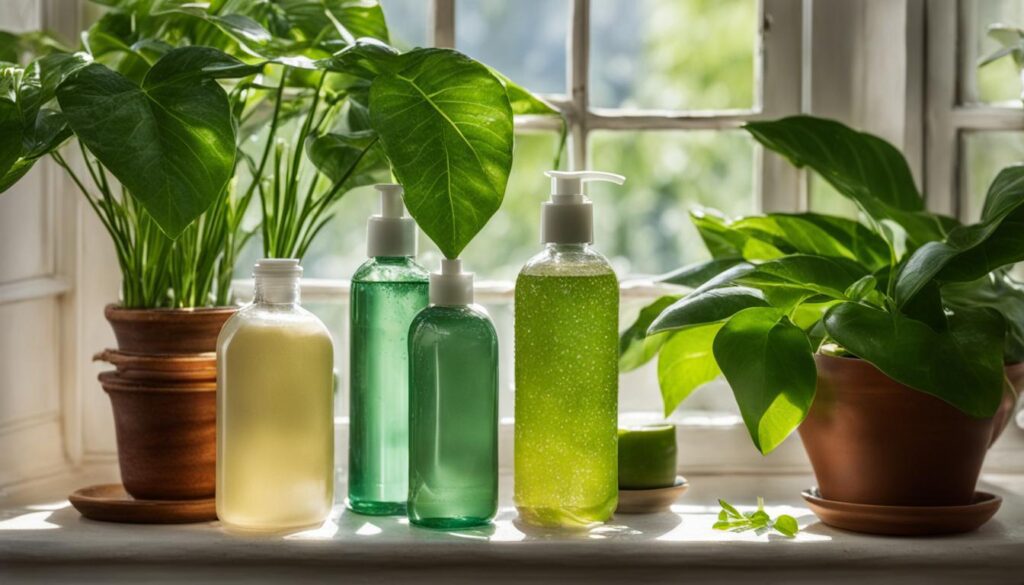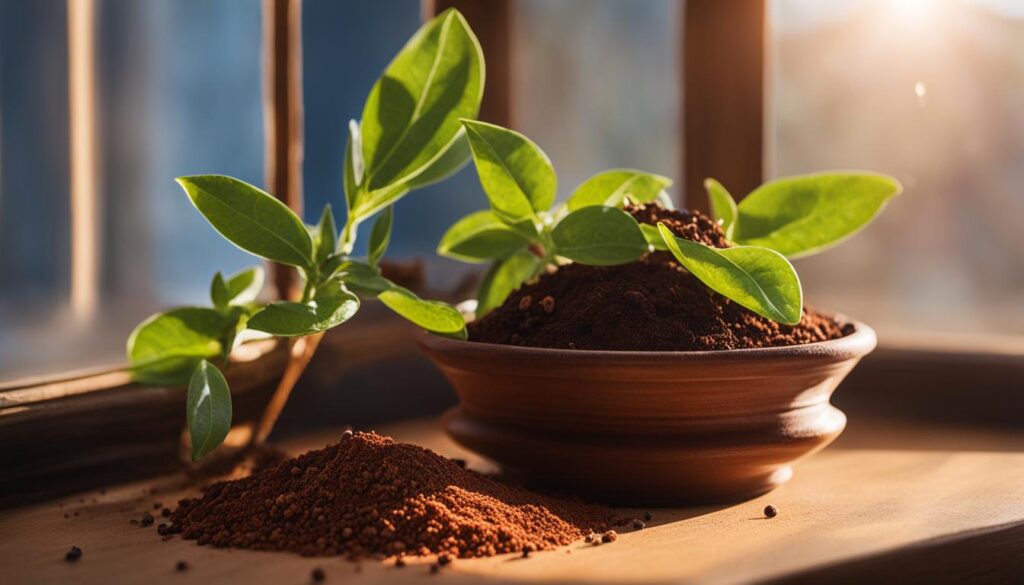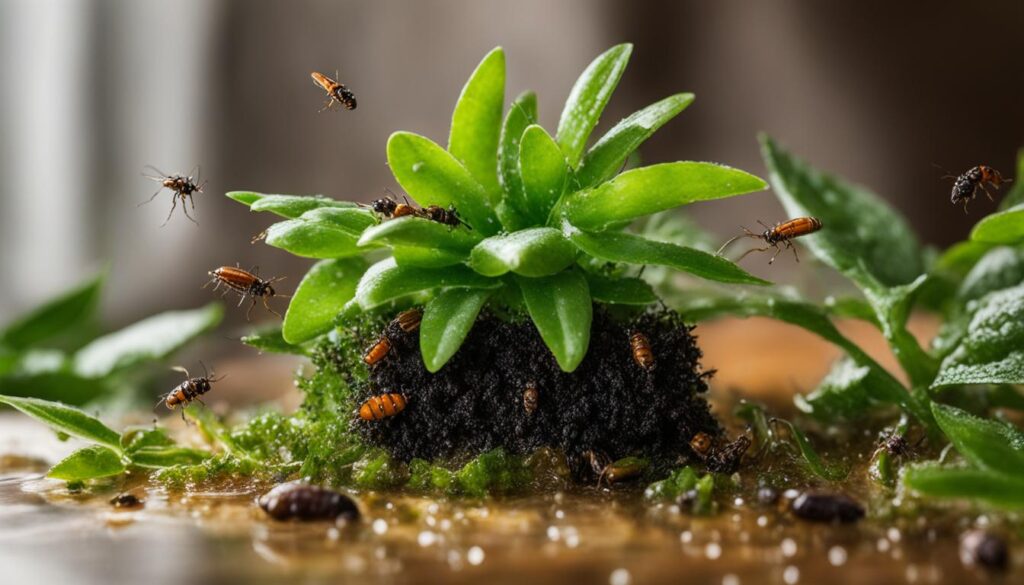Indoor plants provide beauty and tranquility to our living spaces, but dealing with insect pests can be a common struggle for plant parents. Fortunately, there are safe and effective ways to repel bugs from indoor plants using natural ingredients found in your home. By using household items such as dishwashing liquid, cinnamon, vegetable oil, diatomaceous earth, chili and garlic, khakibos, and tomato leaves, you can effectively control pests without the use of harmful chemicals. Let’s explore these natural indoor plant insect repellents and how to use them in your home.
Key Takeaways
- Indoor plants insect repellents offer a natural and safe solution for controlling pests in your home.
- Using household items like dishwashing liquid, cinnamon, vegetable oil, diatomaceous earth, chili and garlic, khakibos, and tomato leaves can effectively repel insects from indoor plants.
- Dishwashing liquid or Castille soap is an excellent natural insect repellent for indoor plants, suffocating pests and deterring them from feeding.
- Cinnamon acts as a natural fungicide and deters fungus gnats from settling in moist potting soil.
- Vegetable oil works against sap-sucking pests by suffocating them and disrupting their metabolism.
Dishwashing Liquid or Castille Soap
Dishwashing liquid or Castille soap is an excellent natural insect repellent for indoor plants. It can effectively eliminate pests like spider mites, mealybugs, and aphids. The soapy residue suffocates the pests and makes the foliage taste unpleasant to them, deterring them from feeding on the plants.
It is important to use a mild dishwashing liquid or Castille soap and dilute it properly to avoid damaging the leaves. A basic recipe for using soap as a pesticide is to mix 1 teaspoon of dishwashing liquid with 1 liter of water and spray it on the plants every 4 to 7 days, making sure to cover both the top and bottom of the leaves.
Cinnamon: A Natural Fungicide for Indoor Plant Pest Control
When it comes to natural solutions for indoor plant pest control, cinnamon is a versatile ingredient that can be used effectively as a natural fungicide. Not only does it add a delightful aroma to your home, but it also acts as a deterrent for pests and helps keep your plants healthy.
Cinnamon’s antifungal properties make it particularly useful for preventing and treating fungal infections in indoor plants. It inhibits the growth of fungi by disrupting their cell membranes, preventing them from spreading and causing damage to your plants. By sprinkling a fine layer of ground cinnamon on the top layer of soil after watering, you can create an inhospitable environment for fungus gnats and discourage mushroom growth.
In addition to its fungicidal properties, cinnamon also acts as a natural insect repellent. It can help deter pests like aphids, mealybugs, and spider mites from infesting your plants. The strong scent of cinnamon is unappealing to these pests, making them less likely to feed on your plants. By incorporating cinnamon into your plant care routine, you can protect your indoor plants from both fungal infections and insect infestations.
Table: Benefits of Cinnamon for Indoor Plant Pest Control
| Benefit | Description |
|---|---|
| Antifungal properties | Cinnamon inhibits the growth of fungi, preventing fungal infections in indoor plants. |
| Insect repellent | The strong scent of cinnamon deters pests like aphids, mealybugs, and spider mites from feeding on your plants. |
| Safe and natural | Cinnamon is a safe and natural alternative to chemical-based pesticides, making it an ideal choice for indoor plant pest control. |
| Aromatic addition | Adding cinnamon to your indoor plants not only helps control pests but also adds a pleasant fragrance to your home. |
Using cinnamon as a natural fungicide and insect repellent is easy. Simply sprinkle a small amount of ground cinnamon on the top layer of soil or directly on the affected areas of your plants. Be sure to cover both the tops and bottoms of the leaves. Repeat this process after each watering or as needed to maintain pest control.
By harnessing the power of cinnamon, you can effectively protect your indoor plants from pests and fungal infections while creating a healthier and more vibrant indoor garden.
Vegetable Oil: A Natural Pesticide for Indoor Plant Pest Control
When it comes to protecting your indoor plants from pests, vegetable oil is a versatile and effective natural pesticide. With its ability to suffocate, disrupt metabolism, and block air holes for pests, vegetable oil provides an eco-friendly solution for controlling sap-sucking insects like aphids, scale, thrips, mealybugs, and spider mites.
To create a vegetable oil pesticide, combine 2 tablespoons of mild dishwashing liquid or Castille soap with 1/2 cup of vegetable oil. Shake well to emulsify the mixture and dilute 2 tablespoons in 1 liter of water. This solution can be applied using a spray bottle, ensuring to cover both the top and bottom of the leaves. Regular application, every 4 to 7 days, will help keep pests at bay and protect your cherished indoor plants from infestations.
| Pest | Vegetable Oil | Application Frequency |
|---|---|---|
| Aphids | Effective | Every 4-7 days |
| Scale | Effective | Every 4-7 days |
| Thrips | Effective | Every 4-7 days |
| Mealybugs | Effective | Every 4-7 days |
| Spider Mites | Effective | Every 4-7 days |
Using vegetable oil as a natural pesticide not only helps protect your indoor plants but also ensures the safety of your home and loved ones by avoiding the use of harmful chemicals. Embrace the power of nature and keep your indoor plants thriving with the help of vegetable oil.
Diatomaceous Earth: A Natural Indoor Plant Pest Control Solution
When it comes to keeping your indoor plants pest-free, diatomaceous earth is a powerful natural insecticide that can do wonders. Made from fossilized remains of algae and microscopic creatures, diatomaceous earth works by physically damaging the exoskeleton of soft-bodied pests like aphids, mealybugs, fungus gnats, ants, thrips, and spider mites. Its sharp fragments pierce the pests, drawing out their moisture and ultimately drying them out.
Using diatomaceous earth as a pesticide is easy. Simply sprinkle a fine layer of it over the potting soil and the leaves of your indoor plants, ensuring that both the tops and bottoms are covered. This will create a barrier that pests cannot cross. However, it’s important to exercise caution while applying diatomaceous earth, as it can become airborne. To protect yourself, wear a mask and remove any pets or children from the area during application.
Diatomaceous earth offers an effective and environmentally friendly solution for controlling pests in your indoor plants. By incorporating it into your pest control routine, you can ensure the health and vitality of your plants without resorting to harmful chemicals.
Table: Comparison of Diatomaceous Earth and Chemical Pesticides
| Aspect | Diatomaceous Earth | Chemical Pesticides |
|---|---|---|
| Effectiveness | Effective against a wide range of pests | Effective, but can harm beneficial insects |
| Safety | Safe for humans and pets when used as directed | Potentially harmful to humans, pets, and the environment |
| Environmental Impact | Biodegradable and does not persist in the environment | Can contaminate soil, water, and air |
| Residual Effects | Does not leave residues on plants | Can leave toxic residues on plants |
As seen in the table above, diatomaceous earth offers several advantages over chemical pesticides. Its effectiveness, safety, minimal environmental impact, and lack of residual effects make it a superior choice for indoor plant pest control. Incorporating diatomaceous earth into your gardening routine can help you maintain a healthy and pest-free indoor plant collection.
Chili and Garlic Spray
When it comes to natural pest control for your indoor plants, chili and garlic spray is a tried and tested solution. Garlic has a strong smell that pests find highly unpleasant, deterring them from feeding on your precious houseplants. Meanwhile, chili peppers contain capsaicinoids, compounds that repel insects and offer protection against fungal and pest attacks.
To create your own chili and garlic spray, start by pureeing two whole garlic bulbs with hot red chili peppers (or chili flakes/powder) and water. Let the mixture steep for 24 hours, strain it, and dilute three tablespoons in 500ml of water. This potent concoction can be sprayed directly onto the leaves of affected plants, ensuring both sides are thoroughly covered. Repeat this process once a week until the infestation subsides.
Using chili and garlic spray not only helps control pests, but it also adds a layer of protection for your indoor plants. By harnessing the natural repellent properties of these ingredients, you can maintain a pest-free environment and keep your plants thriving.
Are Insecticide Houseplants as Effective as Natural Insect Repellents for Indoor Plants?
In the battle against indoor pests, bugfree indoor insecticide plants can be helpful. While they may effectively repel insects, natural insect repellents for indoor plants are also a good option. It’s best to explore different methods and products to find the most effective solution for your indoor gardening needs.
Conclusion
Now that you know about natural pest control for your indoor plants, you can confidently keep them free from pesky insects. By using household ingredients like dishwashing liquid, cinnamon, vegetable oil, diatomaceous earth, chili and garlic, and other plant-based sprays, you can effectively control pests without exposing your home and plants to harmful chemicals.
Remember to follow the proper guidelines when using these remedies. Dilute solutions, test on a small portion of your plant before applying it to the entire plant, and apply treatments away from direct sunlight. These precautions ensure both the safety of your plants and the effectiveness of the treatments.
With natural pest control methods, you can enjoy the beauty and serenity of your indoor plants without worrying about insect infestations. Give your plants the care they deserve, and say goodbye to bugs the natural way.
FAQ
How do I use dishwashing liquid or Castille soap as an insect repellent for indoor plants?
Dilute 1 teaspoon of dishwashing liquid or Castille soap with 1 liter of water and spray it on the plants every 4 to 7 days, covering both the top and bottom of the leaves.
How can cinnamon be used to repel insects from indoor plants?
Sprinkle a fine layer of ground cinnamon on the top layer of soil after watering to prevent fungus gnats and mushroom growth.
How can vegetable oil be used as a natural pesticide for indoor plants?
Combine 2 tablespoons of mild dishwashing liquid or Castille soap with 1/2 cup of vegetable oil. Dilute 2 tablespoons of the mixture in 1 liter of water and spray it on the affected plants, covering both the top and bottom of the leaves.
How is diatomaceous earth effective in repelling pests from indoor plants?
Gently sprinkle diatomaceous earth over the potting soil and leaves of indoor plants to pierce the exoskeleton of pests and draw out their moisture, ultimately drying them out.
What is a homemade garlic and chili spray and how does it repel pests from indoor plants?
Puree two whole garlic bulbs with hot red chili peppers (or chili flakes/powder) and water, allow it to steep for 24 hours, strain it, and dilute 3 tablespoons in 500ml of water. Spray the solution on the leaves of affected plants once a week until the infestation subsides.
Are these natural insect repellents safe to use around children and pets?
While these remedies are natural, it is advisable to exercise caution. Wear a mask when applying diatomaceous earth and keep children and pets away from the treated area during application.
Can I use these natural insect repellents on all types of indoor plants?
These methods are generally safe for most indoor plants, but it is recommended to test a small area first before applying it to the entire plant.











